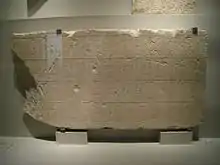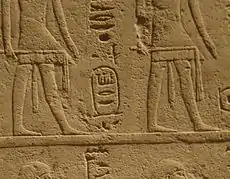Sharek
Sharek or Shalek could have been a poorly known ancient Egyptian pharaoh during the Second Intermediate Period of Egypt.

| Sharek | |||||||||||||||||||||
|---|---|---|---|---|---|---|---|---|---|---|---|---|---|---|---|---|---|---|---|---|---|
| Shalek | |||||||||||||||||||||
 Detail: The genealogy of Ankhefensekhmet (Berlin 23673) is the sole attestation for Sharek | |||||||||||||||||||||
| Pharaoh | |||||||||||||||||||||
| Predecessor | unknown | ||||||||||||||||||||
| Successor | unknown | ||||||||||||||||||||
| |||||||||||||||||||||
The Egyptologists Nicolas Grimal and William C. Hayes have proposed that Sharek should be identified with a king named Salitis, given as the founder of the Hyksos 15th Dynasty in Manetho's Aegyptiaca, a history of Egypt written in the 2nd century BC.[1][2] They further propose that Sharek/Salitis is the same person as Sheshi, a ruler during Egypt's Second Intermediate Period mentioned on nearly 400 scarab seals.
Attestation
He is only attested on a non-contemporary document, a genealogy of a priest named Ankhefensekhmet who lived at the end of the 22nd Dynasty – thus several centuries after Sharek's supposed reign; perhaps for this reason, Danish Egyptologist Kim Ryholt doubts his existence.[3] On the document, Sharek is placed one generation before the well-known Hyksos pharaoh Apepi of the 15th Dynasty.[1] The genealogy of Ankhefensekhmet is now exhibited at the Neues Museum in Berlin (inv. no. 23673).
References
- Hayes, William C. (1973). "Egypt: from the death of Ammenemes III to Seqenenre II". In Edwards, I.E.S. (ed.). The Cambridge Ancient History (3rd ed.), vol. II, part 1. Cambridge University Press. pp. 42–76. ISBN 0-521-08230-7., p. 59
- Grimal, Nicolas (1992). A History of Ancient Egypt. Oxford: Blackwell Books. ISBN 978-0-631-17472-1., p. 185
- Ryholt, K.S.B. (1997). The Political Situation in Egypt during the Second Intermediate Period, c.1800–1550 BC. Copenhagen: Museum Tusculanum Press: Carsten Niebuhr Institute Publications, vol. 20., p. 402